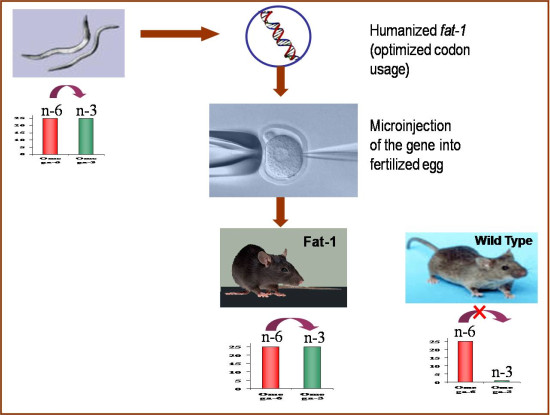Fat-1 Mouse Model |
|
 The fat-1 transgenic mice, generated in our lab, can do what no other mammals can: create their own endogenous omega-3 fats. They carry a transgene, namely fat-1, from the round worm C. elegans, which is capable of converting omega-6 to omega-3 fatty acids. Due to this novel capability, fat-1 mice have an increased content of omega-3 fatty acids with a balanced ratio of omega-6 to omega-3 fatty acids in all tissues and organs, independent of diet. The transgenic mice thus allow researchers to study the biological effects of omega-3 fatty acids in the body without changing diets. Dietary supplementation is a traditional approach to modifying tissue nutrient composition (e.g. fatty acid profile) in animal studies of nutrition. Feeding animals different diets that consist of many components derived from different materials can produce variations between the experimental groups, which may lead to inconsistencies or conflicts in research results. Thus, confounding factors of diet present a major challenge in animal studies of nutrition. The use of this fat-1 mouse model allows the production of two different fatty acid profiles (i.e. high vs. low omega-6/omega-3 ratio) in a litter of mice born to the same mother by using just a single diet (e.g. a high omega-6 diet). For example, mating a fat-1 male heterozygote with a wild type female mouse can produce offspring with two different genotypes: half of them being fat-1 transgenic and other half being wild type. These littermates can then be fed an identical diet but still exhibit distinct fatty acid profiles (high vs. low omega-6/omega-3 ratio in wild type and fat-1 mice, respectively). Thus, this will eliminate the need of two different diets in a comparative study so that the potential variations of the impurities, flavor, calories and other components (including saturated fatty acids, monounsaturated fatty acids, cholesterol, antioxidants, contaminants and other unidentified substances that may also interact with genes) in the supplemented oils (e.g. fish oil vs. corn oil) as well as other factors derived from dietary supplementation such as inconsistent preparation, storage conditions of diet, and timing and duration of feeding can be avoided. Therefore, this mouse model can provide a well-controlled experimental condition without confounding factors of diet for evaluating the health benefits of omeg-3 fatty acids and elucidating the molecular mechanism of their action. In addition, use of the fat-1 mouse model can save a lot of the hassle, time, and money often required for a lengthy feeding (usually for 2-3 months or longer) of different diets in the dietary supplementation studies. In the transgenic mice, the change in fatty acid composition (conversion of omega-6 to omega-3) occurs as early as in the embryo stage and lasts for the whole lifespan. Thus, with this mouse model, it is convenient for one to examine the health effects of omega-3 fatty acids at different ages or time points. Furthermore, fat-1 transgenic mouse lines can be used to genetically cross with established disease models (transgenic or knockout animals, such as ob/ob obesity model and ApoE-/- atherosclerosis model) to generate compound (fat-1 plus a diseased gene) models, which allow addressing the effects of omega-3 fatty acids and or omega-6/omega-3 ratio on the development and progression of the disease. Compared with dietary intervention, a genetic approach is more effective in altering the tissue ratio of omega-6 to omega-3 fatty acids because it can not only increase the absolute amount of omega-3 fatty acids, but also significantly decrease the tissue level of omega-6 fatty acids, leading to a balanced omega-6/omega-3 fatty acid ratio in body tissues without changing the mass of tissue fatty acids (i.e. the total amount of omega-6 plus omega-3 is the same, but the omega-6/omega-3 ratio is different between the transgenic and non-transgenic mice). Thus, this model is ideal for addressing the effects of altered tissue omega-6/omega-3 ratio in the body. These mice have generated a great deal of interest as a tool for studying the effects of changing the ratio of essential fats in the diet. We have so far received more than 100 requests for the fat-1 mice and for collaboration from biomedical scientists worldwide. Our lab is currently collaborating with dozens of research laboratories in different countries to study the health effects of omega-3 fatty acids using the fat-1 transgenic mice. The publications resulting from the fat-1 mouse studies have highlighted the usefulness of the fat-1 mouse model, and have also generated important knowledge from an animal system without confounding factors of diet, for our understanding of the health benefits of these omega-3 fatty acids and how they work at a molecular level. We will continue to use this model together with other genetically modified models of various diseases and the state-of-the art methods and techniques of lipiomics, genetics and proteomics to elucidate the molecular pathways underlying the beneficial effects of omega-3 fatty acids.
Selected Publications:
Workshops on Fat-1 Mouse Model: |
